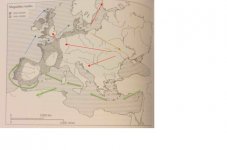The H4 mtDNA project of FTDNA has been doing some work on how and when various subclades of H4 may have migrated. It is best read from the google doc since we can put several pictures alongside the text. So please follow the link to it to understand it better.
https://drive.google.com/open?id=0B9...JiZk1fYnM1d3Q0
This ‘migration summary’ figure shows the movement from ‘Anatolia’ (Turkey) to Spain along the Mediterranean then H4a1a1a along the Atlantic coast to Brittany, Ireland, England Wales and Scotland.
So the overall proposed prehistoric movement of H4a etc becomes these fairly complex movements, first west in 6000-5000 BC (shown in green on picture) followed by north and then east to Scandinavia in 4500 to 3500BC (in blue) and south east through Poland in 3400-2800BC (in orange) then west again, with the Steppe migrations across central Europe which reached the British Isles (again) with the Bell beaker people (shown in red). In the same later period of around 3000BC Finland was settled by farmers.
By this complex route H4 was distributed over Europe.
https://drive.google.com/open?id=0B9...JiZk1fYnM1d3Q0
This ‘migration summary’ figure shows the movement from ‘Anatolia’ (Turkey) to Spain along the Mediterranean then H4a1a1a along the Atlantic coast to Brittany, Ireland, England Wales and Scotland.
So the overall proposed prehistoric movement of H4a etc becomes these fairly complex movements, first west in 6000-5000 BC (shown in green on picture) followed by north and then east to Scandinavia in 4500 to 3500BC (in blue) and south east through Poland in 3400-2800BC (in orange) then west again, with the Steppe migrations across central Europe which reached the British Isles (again) with the Bell beaker people (shown in red). In the same later period of around 3000BC Finland was settled by farmers.

By this complex route H4 was distributed over Europe.

